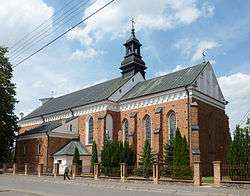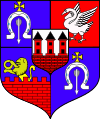Przasnysz
Przasnysz ([ˈpʂasnɨʂ]; Yiddish: פראשניץ, Russian: Прасныш) (German: Praschnitz) is a town in Poland. Located in the Masovian Voivodship, about 110 km north of Warsaw and about 115 km south of Olsztyn, it is the capital of Przasnysz County. It has 18,093 inhabitants (2004). It was one of the most important towns in Mazovia during the Middle Ages. Przasnysz was granted town privileges in 1427.
Przasnysz | |
|---|---|
 Church of the Assumption | |
 Flag  Coat of arms | |
 Przasnysz | |
| Coordinates: 53°1′N 20°53′E | |
| Country | |
| Voivodeship | Masovian |
| County | Przasnysz County |
| Gmina | Przasnysz (urban gmina) |
| Established | 13th century |
| Town rights | 1427 |
| Government | |
| • Mayor | Łukasz Chrostowski |
| Area | |
| • Total | 25.16 km2 (9.71 sq mi) |
| Population (2013[1]) | |
| • Total | 17,326 |
| • Density | 690/km2 (1,800/sq mi) |
| Time zone | UTC+1 (CET) |
| • Summer (DST) | UTC+2 (CEST) |
| Postal code | 06-300 |
| Area code(s) | +48 29 |
| Car plates | WPZ |
| Website | http://www.przasnysz.um.gov.pl |
History
The oldest traces of settlement in the area of Przasnysz come from the turn of the Bronze and Iron Age (around 700 BC). In the 13th century in Przasnysz, on the Węgierka River, there was a market settlement. There was also a hunting court of the Mazovian princes, described by Henryk Sienkiewicz in Krzyżacy. The name of the city according to folk sources comes from the miller Przaśnik, who hosted the stray hunting Prince Konrad I of Mazovia and was then knighted with the surrounding lands.
Przasnysz's rapid development was due to its favorable location on the border between two economically important areas - the Kurpiowska Plain and the agricultural Ciechanowska Upland. On October 10, 1427, Przasnysz obtained the town privilege under the Chełmno law from the Masovian prince Janusz I the Elder. The city flourished in the 16th century, especially after the incorporation of Mazovia into the Crown in 1526. Administratively Przasnysz was part of the Ciechanów District as the capital of a vast powiat.
In 1576, Przasnysz became the seat of the non-castle eldership. In 1648, the Przasnysz eldership was awarded to the defender of Zbaraż, Prince Jeremi Wiśniowiecki.
Fall of Kościuszko Uprising
After the defeat of the Kościuszko Uprising and the Third Partition of Poland (1795), Przasnysz became part of the Prussian monarchy as the seat of a large poviat including Ciechanów.
On January 30, 1807, Napoleon Bonaparte made a visit in Przasnysz.
In the years 1807–1815 Przasnysz was part of the Duchy of Warsaw, and then, after the Congress of Vienna, became part of the Kingdom of Poland, which was part of the Russian Empire.
World War I
During World War I, in November and December 1914, heavy fighting took place near Przasnysz between the Russian and German armies. The city changed hands many times. February 24, 1915 was taken by the Germans, but on February 27 they were forced out by Russian troops from the First and Second Siberian Corps.
Polish-Soviet War and After
In August 1920, extremely fierce battles with the Bolshevik 15 Army took place near Przasnysz. For two weeks the city was occupied by the Soviet army. On August 21, 202 Liberation was brought by Przasnysz Infantry Regiment from the Volunteer Division of Colonel Adam Koc.
In the interwar period, Przasnysz was the capital of the poviat in the Warsaw Province. In the first years of independence, reconstruction from war damage continued. Many public buildings were built: power plant, junior high school and elementary school, agricultural school, city theater, stadium and sports house. The main occupation of the inhabitants of Przasnysz was still agriculture, craft and small trade. In 1938, Przasnysz had 8,000 residents, including approx. 3 thousand Jews.
In the first days of September 1939 near Przasnysz, the Mazowiecka Cavalry Brigade fought hard, under the command of Colonel Jan Karcz. After the September defeat, the Germans joined the Przasnysz District to the Reich.
Soviet Occupation and Modern Day
Shortly after the Soviet army seized the city on January 18, 1945, the NKVD began mass arrests and deportations of Polish patriots. In the years 1945–1951, numerous armed units of the anti-communist underground operated near Przasnysz.
In the 1960s, the rapid development of the city began, slowed as a result of the administrative reform of 1975. In 1966, a branch of Zakład Aparatury Gospodarcza im. Georgi Dimitrov, where lightning arrestors were produced. For the needs of this plant, a school complex was established to house a vocational school and technical college.
Since January 1, 1999, Przasnysz is the seat of the county in the Masovian Voivodeship.
Notable people
- Helga Adler (born 1943) German academic and politician (SED/PDS)
- Stanisław Chełchowski (1866 - zm. 1907) - naturalist and ethnographist
- Moisei Freidenberg (1858-1920) - Russian inventor and journalist
- Aleksander Kakowski (1862-1938) Archbishop of Warsaw
- Stanisław Kostka (1550-1568) - patron of children in the Catholic Church
- Bernard Kryszkiewicz (1915-1945) - Passionist priest
- Abraham Lichtstein - Av Beis Din (head of the rabbinical court) of Przasnysz
- Józef Stanisław Ostoja-Kotkowski (1922-1994) - artist
- Józef Sawa-Caliński (died 1771) - one of the leaders of the Bar Confederation
Coat of arms
The coat of arms of Przasnysz depicts a defensive wall made of red brick on a silver (white) shield, with three such towers of equal height. Each tower is covered with a conical red roof. Each tower has an entrance gate and one soaring hole above it, both black. Heraldic shield border black.
The heraldic image dates from the 16th century.
References
- Demographic Yearbook of Poland 2014 Archived 2016-02-20 at the Wayback Machine
External links
- ePrzasnysz.pl - Your Virtual City, local news from Przasnysz and district
- Jewish Community in Przasnysz on Virtual Shtetl
- Przasnysz city government webpage
- Przasnysz commune government webpage
- Przasnysz on the map, via www.pilot.pl
- webpage about the book "Misjonarze i Barbarzyńcy. Opowieści o codziennym życiu przasnyskiego ogólniaka w latach 1923-2005"
| Wikimedia Commons has media related to Przasnysz. |

